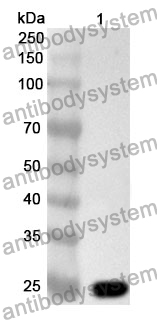Catalog No.
PHG11201
Species reactivity
Human, Mouse, Rat
Host species
Rabbit
Isotype
IgG
Clonality
Polyclonal
Immunogen
E. coli - derived recombinant Human C1QBP (Thr76-Gln282).
Tested applications
ELISA: 1:4000-1:8000, IHC: 1:50-1:100, WB: 1:1000-1:4000
Target
Hyaluronan-binding protein 1,SF2AP32,C1QBP,gC1q-R protein,SF2P32,Glycoprotein gC1qBP,Complement component 1 Q subcomponent-binding protein,mitochondrial,ASF/SF2-associated protein p32,GC1QBP,HABP1,p33,C1qBP,Mitochondrial matrix protein p32
Purification
Purified by antigen affinity column.
Accession
Q07021
Applications
ELISA, IHC, WB
Form
Liquid
Storage buffer
0.01M PBS, pH 7.4, 50% Glycerol, 0.05% Proclin 300.
Stability and Storage
Use a manual defrost freezer and avoid repeated freeze thaw cycles. Store at 2 to 8°C for frequent use. Store at -20 to -80°C for twelve months from the date of receipt.
Macrophages Promote Atherosclerosis Development by Inhibiting CD8T Cell Apoptosis., PMID:39345351
Targeting tumor cell-to-macrophage communication by blocking Vtn-C1qbp interaction inhibits tumor progression via enhancing macrophage phagocytosis., PMID:38773982
Complement protein C1q stimulates hyaluronic acid degradation via gC1qR/HABP1/p32 in malignant pleural mesothelioma., PMID:37334363
gC1qR: A New Target for Cancer Immunotherapy., PMID:36776869
gC1qR/C1qBP/HABP-1: Structural Analysis of the Trimeric Core Region, Interactions With a Novel Panel of Monoclonal Antibodies, and Their Influence on Binding to FXII., PMID:35865516
An approach to p32/gC1qR/HABP1: a multifunctional protein with an essential role in cancer., PMID:35441886
Identification of Mitofusin 1 and Complement Component 1q Subcomponent Binding Protein as Mitochondrial Targets in Systemic Lupus Erythematosus., PMID:35128841
gC1qR Antibody Can Modulate Endothelial Cell Permeability in Angioedema., PMID:34494203
SARS-CoV-2 proteins regulate inflammatory, thrombotic and diabetic responses in human arterial fibroblasts., PMID:33895357
Heterozygous P32/C1QBP/HABP1 Polymorphism rs56014026 Reduces Mitochondrial Oxidative Phosphorylation and Is Expressed in Low-grade Colorectal Carcinomas., PMID:33628739
Role of C1QBP/p32 and its Therapeutic Potential in Breast Carcinoma and other Cancers., PMID:33390103
Therapeutic Zfra4-10 or WWOX7-21 Peptide Induces Complex Formation of WWOX with Selective Protein Targets in Organs that Leads to Cancer Suppression and Spleen Cytotoxic Memory Z Cell Activation In Vivo., PMID:32764489
Autoantigens in the trabecular meshwork and glaucoma-specific alterations in the natural autoantibody repertoire., PMID:32140226
Porcine reproductive and respiratory syndrome virus infection promotes C1QBP secretion to enhance inflammatory responses., PMID:31928703
The C1q Receptors: Focus on gC1qR/p33 (C1qBP, p32, HABP-1)1., PMID:31744753
Phylogenetically Defined Isoforms of Listeria monocytogenes Invasion Factor InlB Differently Activate Intracellular Signaling Pathways and Interact with the Receptor gC1q-R., PMID:31450632
Complement component 1q subcomponent binding protein in the brain of the rat., PMID:30872665
Dynamic Hyaluronan drives liver endothelial cells towards angiogenesis., PMID:29890947
A novel small molecule inhibitor of p32 mitochondrial protein overexpressed in glioma., PMID:29047383
C1QBP is upregulated in colon cancer and binds to apolipoprotein A-I., PMID:28565870
Cytoadhesion to gC1qR through Plasmodium falciparum Erythrocyte Membrane Protein 1 in Severe Malaria., PMID:27835682
Antibody neutralization of cell-surface gC1qR/HABP1/SF2-p32 prevents lamellipodia formation and tumorigenesis., PMID:27363031
Identification of the gC1qR sites for the HIV-1 viral envelope protein gp41 and the HCV core protein: Implications in viral-specific pathogenesis and therapy., PMID:27111569
ADAM28 is expressed by epithelial cells in human normal tissues and protects from C1q-induced cell death., PMID:26918856
Disrupted hyaluronan binding protein 1 (HABP1) expression: one of the key mediator for ovarian dysfunction in polycystic ovary rat., PMID:25300617
cC1qR/CR and gC1qR/p33: observations in cancer., PMID:25044096
Autophagic vacuolation induced by excess ROS generation in HABP1/p32/gC1qR overexpressing fibroblasts and its reversal by polymeric hyaluronan., PMID:24205125
Occlusal trauma accelerates attachment loss at the onset of experimental periodontitis in rats., PMID:23808820
Lectin-dependent enhancement of Ebola virus infection via soluble and transmembrane C-type lectin receptors., PMID:23573288
Gram-positive bacteria as an antigen topically applied into gingival sulcus of immunized rat accelerates periodontal destruction., PMID:23137272
gC1qR expression in normal and pathologic human tissues: differential expression in tissues of epithelial and mesenchymal origin., PMID:22638269
Interaction of HmC1q with leech microglial cells: involvement of C1qBP-related molecule in the induction of cell chemotaxis., PMID:22356764
The formation of immune complexes is involved in the acute phase of periodontal destruction in rats., PMID:22283745
The multicompartmental p32/gClqR as a new target for antibody-based tumor targeting strategies., PMID:21156793
HIV gp41 engages gC1qR on CD4+ T cells to induce the expression of an NK ligand through the PIP3/H2O2 pathway., PMID:20617170
Activation of the plasma kallikrein-kinin system on human lung epithelial cells., PMID:20536386
PPAR-delta senses and orchestrates clearance of apoptotic cells to promote tolerance., PMID:19838202
Systems biology approach predicts immunogenicity of the yellow fever vaccine in humans., PMID:19029902
Evidence for a novel chemotactic C1q domain-containing factor in the leech nerve cord., PMID:18952286
Human p32 is a novel FOXC1-interacting protein that regulates FOXC1 transcriptional activity in ocular cells., PMID:18676636
Expression of complement components and inhibitors on platelet microparticles., PMID:18432523
Novel tyrosine phosphorylated and cardiolipin-binding protein CLPABP functions as mitochondrial RNA granule., PMID:18191643
The exosporium of B. cereus contains a binding site for gC1qR/p33: implication in spore attachment and/or entry., PMID:17892212
HCV core protein interaction with gC1q receptor inhibits Th1 differentiation of CD4+ T cells via suppression of dendritic cell IL-12 production., PMID:17881511
Classical pathway complement activation on human endothelial cells., PMID:17173972
Blood platelets activate the classical pathway of human complement., PMID:16961611
gC1qR/p33 serves as a molecular bridge between the complement and contact activation systems and is an important catalyst in inflammation., PMID:16893067
Acetylated Tat regulates human immunodeficiency virus type 1 splicing through its interaction with the splicing regulator p32., PMID:16537587
gC1q receptor ligation selectively down-regulates human IL-12 production through activation of the phosphoinositide 3-kinase pathway., PMID:16177118
Chemotaxis of human monocyte-derived dendritic cells to complement component C1q is mediated by the receptors gC1qR and cC1qR., PMID:16140380

